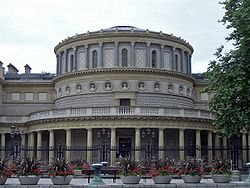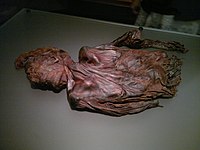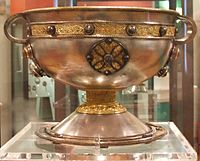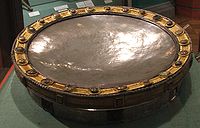National Museum of Ireland – Archaeology
| The National Museum of Ireland - Archaeology Irish: Ard-Mhúsaem na hÉireann – Seandálaíocht | |
|
County Dublin | |
|---|---|
 Entrance to the museum | |
| Type: | museum |
| Location | |
| Grid reference: | O16273363 |
| Location: | 53°20’25"N, 6°15’18"W |
| City: | Dublin |
| History | |
| Address: | Kildare Street |
| Built 1890 | |
| museum | |
| Information | |
| Website: | www.museum.ie |
The National Museum of Ireland – Archaeology is a branch of the National Museum of Ireland, dealing with Irish and other antiquities. It stands on Kildare Street in Dublin, County Dublin.
In general, the museum covers the history of Ireland from the Stone Age to the Late Middle Ages. Many important artefacts from the museum were featured in The Irish Times feature and book A History of Ireland in 100 Objects.[1]
It features displays on prehistoric Ireland, including Bronze Age work in gold, early mediæval church treasures of Celtic art, Viking Ireland and Mediæval Ireland. There are special displays of items from Ancient Egypt, Cyprus and the Roman world, and special exhibitions are regularly mounted.
Permanent exhibitions
The Museum has a number of large permanent exhibits, mainly of Irish historical objects and also a few smaller exhibits on the ancient Mediterranean.[2]
Prehistoric Ireland
The prehistoric Ireland section contains artefacts from the earliest period of human habitation in Ireland (just after the Last Ice Age) up to the Celtic Iron Age. There are numerous stone implements created by the first hunter-gatherer colonists beginning around 7000 BC, then moving on to the tools, pottery and burial objects of the Neolithic farmers. Some notable artefacts include four rare Jadeite axeheads imported from the Alps of Neolithic Italy, and the unique ceremonial macehead discovered at the tomb of Knowth.[3][4] The exhibit then covers the introduction of metallurgy into Ireland around 2500 BC, with early copper implements. From the later Bronze Age period there is an impressive array of bronze axes, daggers, swords, shields, cauldrons and cast bronze horns (the earliest known Irish musical instruments). There are a few very early Iron weapons. Wooden objects include a large dugout logboat, wooden wheels and cauldrons and ancient reed fishing equipment.[5]
Ór - Ireland's Gold
The central area of the museum contains one of the finest collections of Bronze Age gold objects in Europe.[6] The goldwork ranges in date between 2200 BC and 500 BC, most of it probably being jewellery, but with many objects of unknown (possibly ritual) function. In the early Bronze Age most artefacts were made from sheet gold and include sundiscs and crescent shaped collars called lunulae. In the middle Bronze Age new gold working techniques were developed; starting around 1200 BC a great variety of torcs were produced from twisting bars of gold. Items from the late Bronze Age, starting in 900 BC, include solid gold bracelets and dress-fasteners as well as large sheet gold collars, ear-spools and a necklace of hollow golden balls.[7][8]
-
Gold collars ( 800-700 BC) from Tonyhill in Co Limerick (left) and Co Clare (right)
-
Gold Dress Fastener, Clones, County Monaghan (800-700 BC)
-
Gold Dress Fastener found in wooden box in Killymoom Demesne, Tyrone (800-700 BC)
Kingship and Sacrifice

This new exhibit (opened in the 2000s) contains many of Ireland's bog bodies, as well as Celtic artefacts. The well-preserved bodies, which have been found in Irish bogs from the 19th century until the present day, are believed to have been ritualistically sacrificed. Eamonn Kelly (former Keeper of Irish Antiquities) developed the theory that the bog bodies were tribal kings, sacrificed by the community after having failed in their kingship and placed in pools of water at the boundary points of the tribal territory.[9][10] Some seem to exhibit evidence of the so called 'threefold death' practice.[11]
The currently displayed bog bodies are:
- Gallagh Man (discovered 1821, dated to 400 to 200 BC)
- Baronstown West Man (discovered 1953, dated to 242 to 388 BC)
- Clonycavan Man (discovered 2003, dated to 392 to 201 BC)
- Old Croghan Man (discovered 2003, dated to 362 to 175 BC)
The museum has an extensive research program to study the bog bodies with the latest scientific methods. Marie Cassidy, the then State Pathologist, aided in forensic examination of several of the recently discovered bodies.
Alongside the bodies are examples of the material culture of the period in which they lived (the Celtic Iron Age). These include metal weapons and horse trappings as well as wooden and leather pieces. The Petrie crown (named for George Petrie) is part of a high-status headdress made in the La Tène artistic style. The section also contains Ralaghan Man, a carved wooden figure believed to be a boundary marker and examples of bog butter, which is ancient butter preserved in the bog in containers such as wooden buckets. The museum also possesses several other bog bodies not currently displayed, such as the recently discovered Cashel Man (discovered 2011, dated to ~2000 BC), believed to be the oldest fleshed bog body found in Europe.[12]
The Treasury
The Treasury exhibit includes such pieces as the Ardagh Chalice and the Tara Brooch, as well as the Broighter Gold, the Derrynaflan Hoard and the Cross of Cong, all famous examples of early mediæval metalwork in Ireland.
-
Broighter Hoard, boat, bowl, and part of the torc
-
Tara Brooch
-
The Ardagh Chalice, centrepiece of the Ardagh Hoard
-
Derrynaflan Paten
New exhibits, Viking and Mediæval Ireland
The most recent permanent galleries to open are Viking Ireland[13] and Mediæval Ireland 1150-1550.[14] There are also galleries on "Ancient Egypt",[15] and "Ceramics and Glass from Ancient Cyprus".[16]
Recent temporary exhibitions have included: "Roger Casement - voice of the voiceless", "Rites of Passage at Tara", "Clontarf 1014: Brian Boru and the Battle for Dublin", and "Life and Death in the Roman World".
History
Many of these pieces were found in the 19th century by peasants or agricultural labourers, when population expansion led to cultivation of land which had not been touched since the Middle Ages. Indeed, only the intervention of George Petrie of the Royal Irish Academy, and like-minded individuals from the Royal Society of Antiquaries of Ireland, prevented the metalwork from being melted down for the intrinsic value of its materials. Contemporary Irish are more tuned to their heritage, as can be seen in the example of the Irish Bog Psalter, which was discovered and reported by an alert machine operator in July 2006.[17]
The Museums of both the Royal Irish Academy and of the Royal Society of Antiquaries of Ireland formed the basis for the Archaeology and History section of the Museum at Kildare Street. This is the original site opened in 1890 as the Dublin Museum of Science and Art in the building designed by Thomas Newenham Deane and his son, Thomas Manly Deane. Until 1922, this site also included Leinster House, now the home of the Oireachtas.
References
- ↑ http://www.100objects.ie/
- ↑ Permanent exhibitions National Museum of Ireland – Archaeology
- ↑ Guide to the National Museum of Ireland Archaeology
- ↑ Knowth Macehead newgrange.com
- ↑ Prehistoric Ireland exhibit
- ↑ "home to the finest collection of Bronze Age and Iron Age gold artefacts in the world", Lonely Planet Ireland's Best Trips, Lonely Planet, 2017 ISBN 1787010244, 9781787010246, Lonely Planet, Fionn Davenport, Catherine Le Nevez, Isabel Albiston
- ↑ Ór - Ireland's Gold museum.ie
- ↑ A Late Bronze Age gold necklace from Tumna, Co. Roscommon Irish Archaeology
- ↑ Kingship and Sacrifice - An exhibition of Iron Age bog bodies and related finds museum.ie
- ↑ Kingship and Sacrifice - Read about the Bog Bodies Research Project at the National Museum of Ireland - Archaeology museum.ie
- ↑ Irish bog bodies, some recent discoveries Irish Archaeology
- ↑ Cashel Man: Ireland's Oldest Bog Body museum.ie
- ↑ Viking Ireland museum.ie
- ↑ Mediæval Ireland 1150 - 1550
- ↑ Ancient Egypt, NMI
- ↑ Ceramics and Glass from Ancient Cyprus
- ↑ Manuscript dug from bog rates among our top 10 biggest finds
| ("Wikimedia Commons" has material about National Museum of Ireland – Archaeology) |
| National Museum of Ireland |
|---|
|
Archaeology • Country Life • Decorative Arts and History • Natural History |







